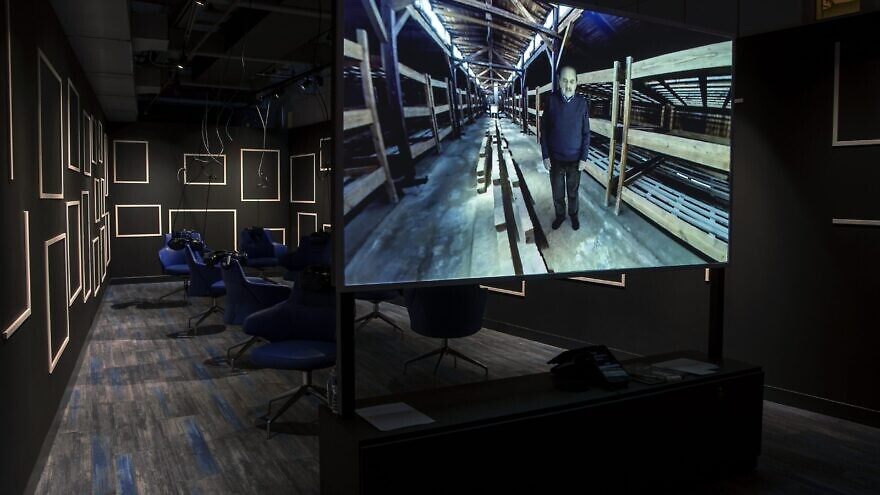Jordan Gelfeld has connections. As a docent at the Illinois Holocaust, his grandfather, Mark Gelfeld, was able to get this grandson in for a sneak peek at the museum’s new virtual-reality exhibit. And the experience was nothing short of powerful.
“You can read about the Holocaust in books, but with this, you really feel like you’re there with ‘George,’ ” said the Glenbrook North High School sophomore, referring to a story about a survivor. “Even though you are sitting there in your chair, it feels like you’re in the camp, surrounded by the other prisoners.”
Organizers at the Illinois Holocaust Museum chose International Holocaust Remembrance Day on Jan. 27 for the official rollout of their new cutting-edge virtual-reality Holocaust experience, titled “The Journey Back.” With 360-degree life-sized projections, once inside the 3-D environment, the participant controls their own view of reality, interspersing contemporary footage with memory sequences, and giving the sensation of being on-site with two Chicago-area survivors sharing their stories.
The What: The museum is presenting two films in its new virtual reality theater. “A Promise Kept” tells the story of Fritzie Fritzshall. As a young teen, she made a vow to the other 599 women imprisoned with her in a slave-labor sub-camp of Auschwitz that, if she survived, she’d never let their fates be forgotten.
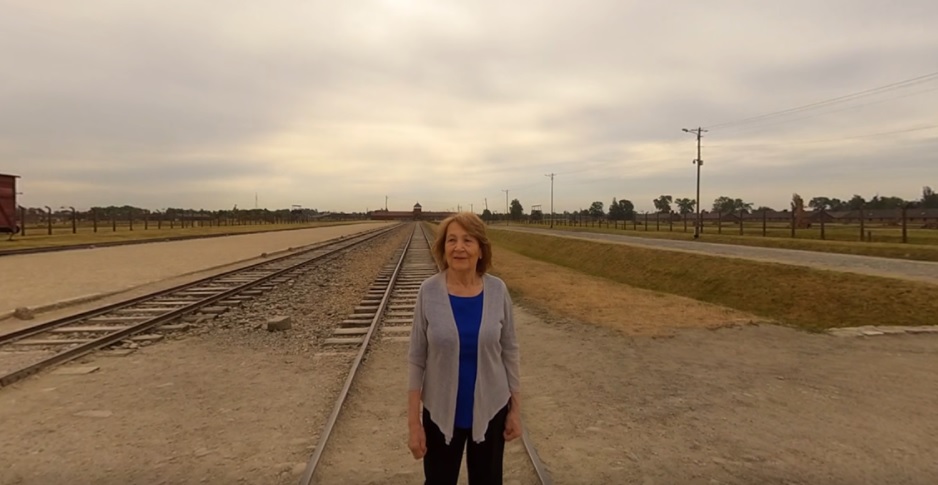
At night, one woman might start a song or a prayer, and the others would chime in quietly. “But mostly we shared recipes—gefilte fish, kugels, roasts,” Fritzshall told the camera. “Our stomachs were growling from hunger, but we had to live in a pretend world.”
Slabbed with 10 other women on a bunk, “I remember my aunt Bella putting her arms around me and whispering, ‘Tomorrow will be better; let’s just live through the night and you’ll see, tomorrow will be better.’ ” Sadly, her aunt did not survive.
The other film, “Don’t Forget Me,” takes viewers on a journey back to Auschwitz, Mauthausen and Ebensee concentration camps with George Brent, who was also a teen when his family was taken from their Hungarian home as his friend happily took his bicycle and neighbors emptied out their home. Nor can he forget the terrifying trip to Auschwitz, where he soon learned “what the two buildings with large chimneys with smoke and fire and a terrible smell” were about, and the rigors of Mauthausen where many men’s backs were broken carrying huge boulders from the quarries up the “staircase of death,” while others gave up and leaped to their deaths.
Although Brent knew his mother and brother had been killed on arrival at Auschwitz, he never knew his father’s fate till a year after liberation when the Red Cross located him in a tuberculosis clinic in Germany.
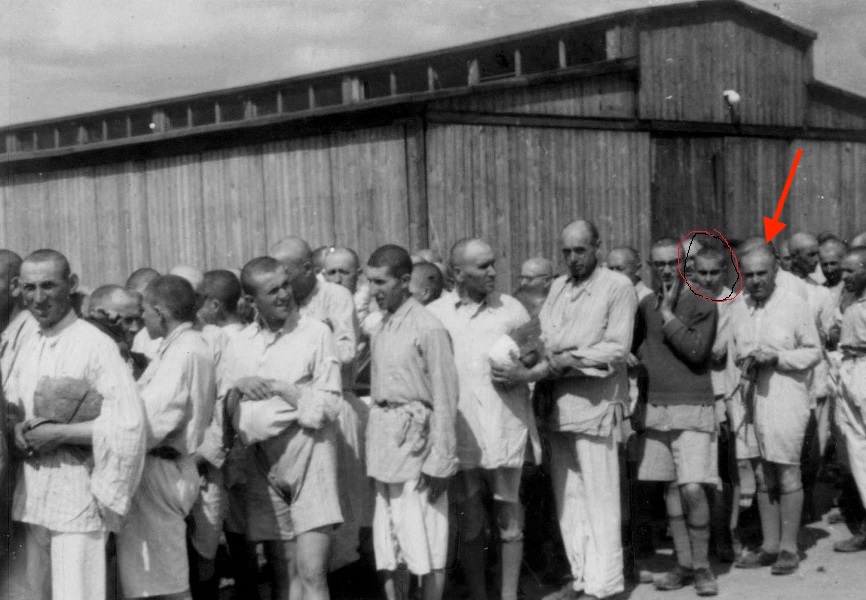
The Why: “We need to learn all we can from Holocaust survivors while they are still here,” says museum CEO Susan Abrams. “The knowledge we gain from their pasts influences our futures and informs the way we interact with the world. And there is truly no better way to learn than to virtually tour the Holocaust sites today with a survivor to see them from their point of view.”
Expecting thousands of visitors to experience the virtual reality tour of the camps each year, the museum has plans in the works to share the program with other museums equipped with the virtual-reality technology, in addition to universities and, down the line, schools and individuals as well.
“‘The Journey Back’ brings to life the moving testimony of two survivors at the locations where they experienced the worst of humanity, and that experience inspires an understanding of our common humanity,” says Abrams. “And time is of the essence for growing such understanding. We’re swimming against a tide of rising anti-Semitism, and other forms of hatred and bigotry. As the Holocaust recedes into the past and most of the survivors have passed away, this is an important moment for this kind of personal, powerful experience.”

The Who: Not only can survivor Brent not forget the image of desperate men jumping to their death from the quarries of Mauthausen; now, neither will viewers of “Don’t Forget Me.”
After his reunion with his father, Brent made it to Chicago in 1949 and was soon drafted into the U.S. Army to serve in the Korean War. Marriage, dental school, a practice, four daughters and eight grandchildren followed, and after he retired, Brent began telling his story in earnest, often to school kids visiting the museum.
“Seeing a picture of myself—a kid in my underwear—in a book of Auschwitz photos proved to everyone that it was real,” says Brent who, at 92, has been telling his story for decades. “I can see the effect it has on the eighth-graders who come to the museum,” he says, with most of the questions he gets from his young audiences about what became of his family and how he felt in the camps. Many youngsters also ask to see the numbers tattooed on his arm—and he shows them.
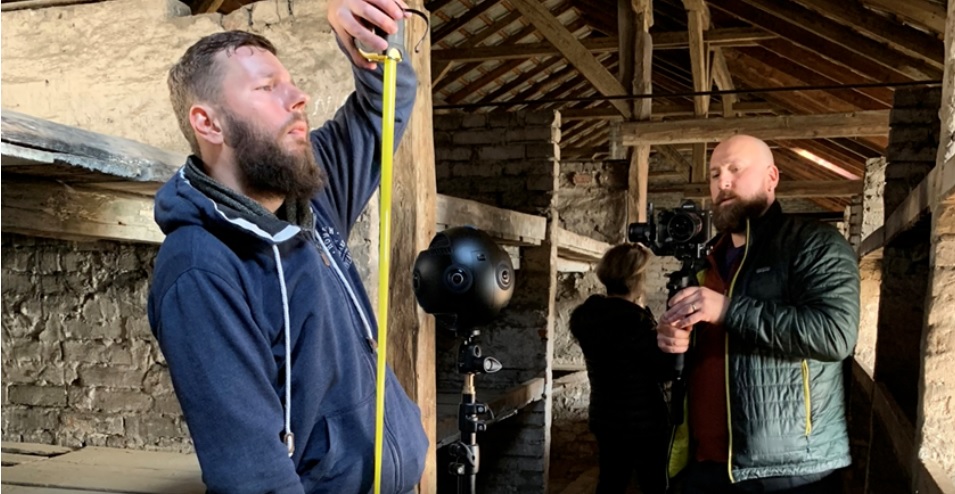
The Audience: Kelley Szany, the museum’s vice president of education and exhibitions, says the multisensory nature of the virtual-reality experience is singular in the way it meets the challenges of creating an understanding of the lethal nature of hate in the minds and hearts of the next generation.
“From an educational standpoint, feeling that they visited the sites with Fritzi and George, shared their experiences and felt their feelings, it’s a merger of technology and storytelling,” she says. “As it’s seared into their memories, and they begin to grapple with how to understand what they’ve learned here, it can ultimately make the world a better place.”
The experience, adds Szany, is recommended for ages 12 and up, “who are usually mature enough cognitively and emotionally to be able to dive into the difficult aspects of this history.”
The Backstory: When it comes to high-tech bringing Holocaust experiences to life and preserving them for future generations, in many ways, Steven Spielberg was the first to accomplish it on a grand scale. Beginning in the 1990s, a broad interviewer network collected more than 50,000 filmed testimonies of Holocaust survivors—and some witnesses, too (most of whom are since deceased); this collection is now known as the Visual History Archive and housed at USC Shoah Foundation. This massive project came on the heels of the 1994 Academy Award-winning “Schindler’s List,” whose profits seeded it.
Earlier Holocaust-related VR projects included “Lala,” the partly animated short film created by USC Shoah Foundation with survivor Roman Kent. The story of the dog belonging to Kent as a child in Poland during the Nazi invasion was designed to introduce children to the Holocaust and can be viewed with or without a VR headset.
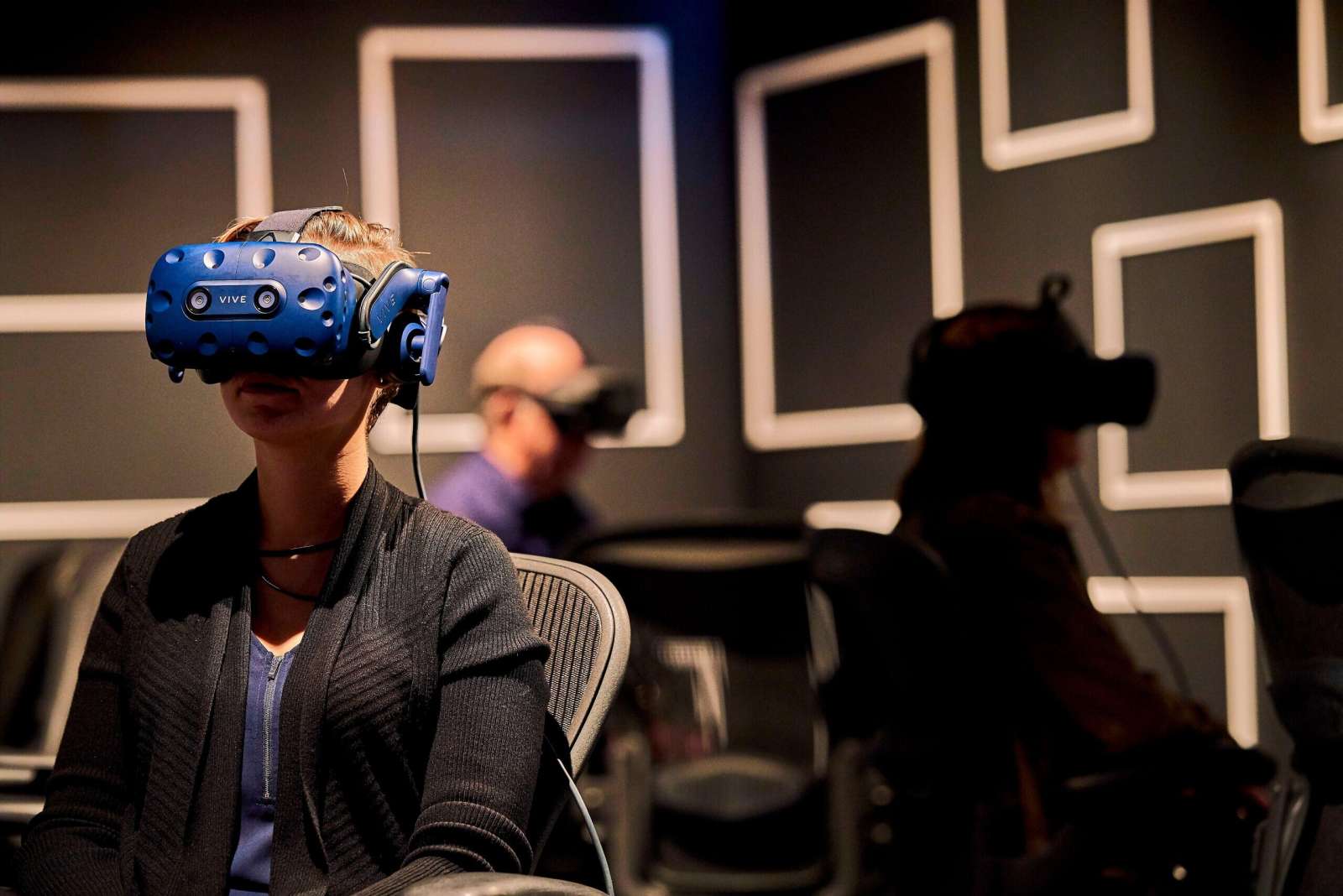
Another VR Holocaust milestone was 2017’s “The Last Goodbye,” also out of the Shoah Foundation. Following survivor Pinchas Gutter into Nazi death camp Majdanek, the short film records his experience as the only member of his family to emerge from the Holocaust alive.
And that same year the Illinois Holocaust Museum was among the first institution to use hologram technology developed by USC Shoah Foundation, which invites visitors into a “conversation” with a survivor. Each time a question is asked, one of some 2,000 answers the survivor recorded is played, mimicking a live Q&A.
At the museum’s Abe & Ida Cooper Survivor Stories Experience, for instance, this hologram program also featured Fritzshall, who spent 40 hours over five days recording 2,000-plus answers.
“It stirred up a lot of the memories that I didn’t want to think about anymore, that I thought were hidden,” she said at the time.
Still, added Fritzshall, who passed away last summer, “I am glad that I did it, I am so glad that it is going to be left in this museum as a teaching tool, for all the young people who come here. Maybe they will talk to their parents and grandparents and talk to the next generation; this is what I’m hoping today.”
‘How to transmit their voices and emotions’
But using this technology on such sensitive topics can take some getting used to. “At first, I was a little bit skeptical; I was raised in a generation when we took it for granted that survivors come into our schools to talk to us,” says Sara Brown, who managed post-secondary education programming for USC Shoah Foundation before joining CHHANGE (the Center for Holocaust, Human Rights & Genocide Education) as executive director. “It never occurred to me that we were in the sunset stage, the last generation who would hear their stories in person.”
That is, until she stepped into the field of Holocaust education. She notes: “Then I began to see it’s up to us to keep the survivors’ voices alive into the future.”
The development of such modern technology for conveying such painful, and almost unbelievable, experiences, says Brown, “allows us to meet people, especially adolescents, where they’re at, through powerful experiential learning.”

But she also conveys a warning: “Though I firmly believe these meaningful encounters are the future of Holocaust education, they need to be done right. Presenting it as shock-and-awe can do real harm, especially to children.”
Wojciech Soczewica, director general of the Auschwitz-Birkenau Foundation, who was in Chicago last week to test drive the museum’s new VR exhibit, agrees. “It’s a very personalized experience,” he says, “giving the viewer the chance to not only listen to the survivors’ tragic histories and to walk along with them in the concentration camp, but to see how they managed to survive and kept the promises they made.”
In fact, they’re mid-stream in creating a VR program at the Auschwitz-Birkenau site, he adds, featuring a virtual reconstruction of the camp in 1944, when it was in its murderous peak, to be used by anyone with a VR headset, including in classrooms. “We’re doing it to tell the story of evil in the Shoah and build momentum against it,” adds Soczewica. “With the survivors passing away, this is how to transmit their voices and their emotions.”
But even as they leave the world, “the survivors are still our master teachers,” stresses Brown. “They had the courage to share their painful experiences with us so, as Eli Wiesel said, we must now be their witnesses; we owe that to them. To train the next generation that, when they see hate, to be upstanders and not bystanders.”
“Their stories have to be kept alive with the goal of inspiring empathy,” affirms Abrams. “To create a world where ‘never again’ is a reality.”
As for Jordan, he says “it’s so crazy that I’m the same age George was then. I can’t even imagine what that would be like.”
If all his fellow students at school experienced the exhibit, what might the impact be?
Jordan replies that “if their thinking is prejudiced, this could make them more curious about what happened then and open up their eyes.”
And, to give the survivor the final word: “I’ve gotten a great deal of satisfaction that I can still tell my story,” says Brent. “With this new technology, now that there aren’t too many of us left, it can help extend the understanding of what we went through into the future.”


























